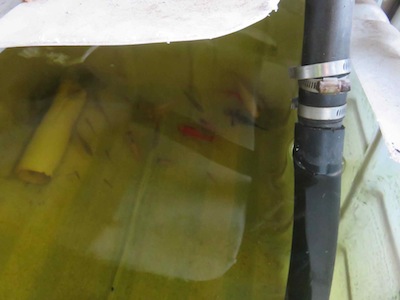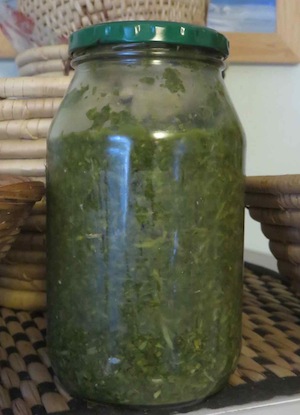Dear Reader, in this age of AI created content, please support with your goodwill someone who works harder to provide the human-made. Sign up at the top of the lefthand column or bottom of this page. You will receive my hand illustrated monthly newsletter RESTORE NATURE and access to the biodiversity garden design course as I write...and nothing else, I respect your time. I am also removing the advertizing as best I can as its become intrusive inappropriate and pays me nothing.
Growing mint and using it in the kitchen
 mint flourishing in our home garden's aquaponic system
mint flourishing in our home garden's aquaponic systemMint needs lots of water
Growing mint is easy if you give it plenty of water and a little urine. It seems you can’t give it too much water.
We have an aquaponic system. Last year in January Stephan planted a small mint plant with other seedlings into the biofilter of his new aquaponic system and placed a small fish population in the water tank connected to it. These fish supply tiny amounts of urine, as fish pee in the water they swim in. This must be removed from a small closed system in order to keep the fish healthy.
 When the mint plant was small you could see it all
When the mint plant was small you could see it allA little nitrogen helps
At first the leaves of the mint were quite yellow, while the fish were small. Koi grow rapidly in their first year, and as they grew, the leaves became greener with access to more nitrogen.
 supporting fish supply nitrogen to the mint growing system
supporting fish supply nitrogen to the mint growing systemSatisfy these requirements and growing mint is easy
I have always fancied the idea of growing mint but found it difficult. In retrospect I realize I could not supply it with sufficient water, growing in the ground in this dry climate, in my water wise garden. But now we have been growing mint very successfully for over a year. We have let that same small plant utterly take over the biofilter. To check the outflow from the fish tank that used to be easy to see, I have to pull apart a jungle of leaves and stems.
 the water outflow from the tank is deep in a mint jungle
the water outflow from the tank is deep in a mint jungleGrowing mint from seed is an exercise in patience, a thing which we are learning as we grow more and more plants, but so far we have not succeded in growing mint from seed. This is because we bought the mint plant for the aquaponic system from a nursery and it flowered profusely in summer with white blossoms, but produced no seed. However it has become so large that it now it trails on the ground and can be layered to propagate it. This is in fact the most common way of growing mint and it is due to the ease with which it takes root. We could also check in the filter and try and remove any new suckered plants which have developed with roots. However the plant is so dense, I fear that I may damage it in so doing.
 Stephan with his very successful mint protege
Stephan with his very successful mint protegeStephan is still surprised by the success of his mint planting, although he found the photo shoot a bit tedious and looked very resigned.
I harvest the mint almost daily, a good fistful serves for the day’s tea, since I cut back on caffeine. I combine the mint with our indigenous Rooibos tea, which is available here in the supermarket. To prepare mint tea the trick is quick immersion. To infuse your tea with the delightful aroma of fresh mint, the mint should be exposed to boiling water for a minute or so, and then removed, otherwise it begins to taste and smell of boiled vegetables.
 my mint tea ration for the day
my mint tea ration for the dayFrom time to time it needs severe cutting back, and then I take the trimmings, strip off the leaves and put them in a blender with vinegar to make mint sauce. I add only enough vinegar to make the leaf mass workable during processing, and in order for it not to dry out and brown and go bad. It isn't liquid but a stiff paste. Mint sauce adds a little sourness and a lot of herbal aroma to any combination, and freshness par excellence.
It is perfect with traditional sambals made to accompany Indian curries or South African farm style pickled fish, recorded by Stephan on his recipe website. Combine with the carrot sambal, and add-ons like coconut, banana and yellow rice with raisins for a delicious Cape farm style flavour feast.
When my Aunt and Grandmother were still around, they served Christmas meat roasts with deep fried whole roast potatoes and mint sauce, a delicious treat. It cuts through excessively oily and fatty dishes to make them more palatable, and it really is very versatile in other contexts. I’ve tried it with many different foods from sandwiches to stews, plopped on yoghurt and cucumber salad, and with legumes such as lentils and peas.
------
home page for lots of links to how to pages on eco friendly natural gardening
------
You’re a home gardener ! Share your experiences and questions !
We all know about home gardening. Tell us about your successes, challenges and ask about issues that bother you. You may have the luxury of a back garden, but there are other ways we learn. Few people age without growing something or buying vegetables during their lives ! It is absolutely guaranteed that you have learned things which can help others on their gardening journey.
We invite you to share your stories, ask questions, because if a thing has bothered you it will bother others too. Someone may have a solution ! No question is too small. There is learning for everyone involved, for you, for me (yes, I learn from every question), for us all. Exciting stuff !
We are starting on a new journey. Every week we will profile your letters ! The best stories and questions we receive.
What Other Visitors Have Said
Click below to see contributions from other visitors to this page...
mint growing like a bomb Not rated yet
I found a picture of the growing mint plant when it was showing promise but still very young and thought I'd just post it too.
Restore Nature Newsletter
I've been writing for four years now and I would love to hear from you
Please let me know if you have any questions, comments or stories to share on gardening, permaculture, regenerative agriculture, food forests, natural gardening, do nothing gardening, observations about pests and diseases, foraging, dealing with and using weeds constructively, composting and going offgrid.
SEARCH
Order the Kindle E-book for the SPECIAL PRICE of only
Prices valid till 30.09.2023
Recent Articles
-
garden for life is a blog about saving the earth one garden at a time
Apr 18, 25 01:18 PM
The garden for life blog has short articles on gardening for biodiversity with native plants and regenerating soil for climate amelioration and nutritious food -
Cape Flats Sand Fynbos, Cape Town's most endangered native vegetation!
Apr 18, 25 10:36 AM
Cape Flats Sand Fynbos, a vegetation type found in the super diverse Cape Fynbos region is threatened by Cape Town's urban development and invasive alien plants -
Geography Research Task
Jan 31, 25 11:37 PM
To whom it may concern My name is Tanyaradzwa Madziwa and I am a matric student at Springfield Convent School. As part of our geography syllabus for this
"How to start a profitable worm business on a shoestring budget
Order a printed copy from "Amazon" at the SPECIAL PRICE of only
or a digital version from the "Kindle" store at the SPECIAL PRICE of only
Prices valid till 30.09.2023









